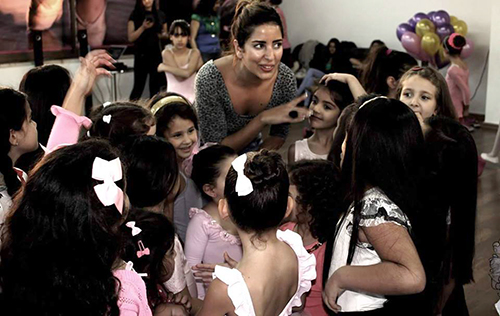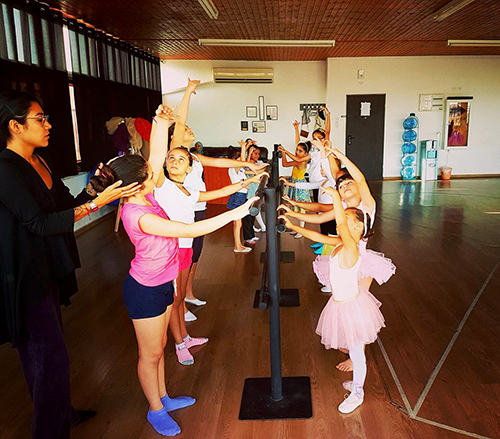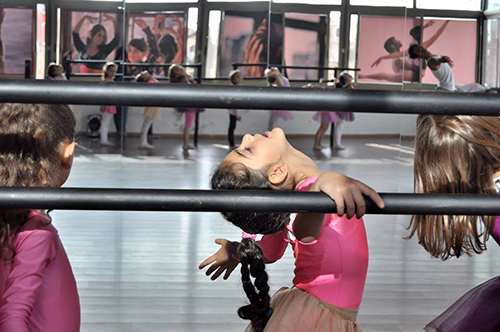Finding Freedom in Palestine through Dance
An Interview with Shyrine Ziadeh
BY EMMALY WIEDERHOLT
Shyrine Ziadeh is the founder and director of the Ramallah Ballet Center, a ballet school in Ramallah, Palestine. Her story of how she built a ballet school from scratch is a powerful reminder of how dance can impact a community.
~~
Tell me a little about your dance background.
I started dancing when I was four or five years old. As part of our after-school activities, we had international teachers come to Palestine as volunteers. Then there were a few years when there were no dance teachers in Ramallah, the city where I live. When I was 13, I discovered a woman living here who was married to a Palestinian. She had been a dancer. I went to her and told her I wanted to continue learning dance. I used to imitate the belly dancers on TV from the Egyptian movies. I loved it.
I got the basics of ballet, jazz and contemporary dance. There were maybe five of us students. I continued dancing with this teacher until I finished high school. After that, I couldn’t continue dance because there was no dance offered in college. Meanwhile my teacher went back to her hometown.
In university, I studied business administration, but I also felt that I needed to continue to dance. I decided to teach kids from my own humble experience. I was very honest; I told parents I don’t have a certificate in dance, but I have experience.
I started to volunteer in summer camps. This was during my last year of university. The kids loved it, and parents encouraged me to offer more classes, so I found a place by a church. I spoke to the priest, and he gave me the space for free to teach. The space wasn’t suitable for dancing, but many people came anyway.
I graduated in 2010 and, in 2011, I started the Ramallah Ballet Center page on Facebook. I wanted to see what the reaction would be, if more people would come to take classes. It worked; many people came, and many parents encouraged me to find a better space.
I knew I needed a fund. I started a real job but, at the same time, my mind was on art and dancing. My job didn’t cover what I needed to open a studio, so I asked my parents to give me a seed fund. They supported my idea, and gave me the seed funding.
I found a space in the old city. We started with 10 kids, and now we have between 30 to 60, depending on the season. We also offer contemporary, yoga and salsa for adults. There are also workshops for women in villages and camps. It’s not only the studio; it’s a larger movement.
What exactly does the Ramallah Ballet Center offer in terms of classes?
We offer ballet classes for kids ages three to 14. For adults, we offer contemporary ballet, yoga, salsa and belly dance. We also offer workshops, but those are irregular. It depends on the teachers. I’m always under pressure to find teachers. By chance I found a dance teacher living here with her husband for three years. She’s worked with the students for one year now, and will continue for two more years. It’s amazing how much the students’ technique has improved in the past year.
How have you seen your students grow through dance?
When they first came, they were shy. They didn’t know what ballet is. We started with movement games with the young ones. Soon, they loved it and wanted to continue. I saw smiles on their faces.
When I started teaching, I wanted to be very strict and offer technique, but I saw that my students just wanted to express. They didn’t want to memorize rules and steps, so I taught them ballet basics and we switched to contemporary. Now the students are more confident. Dance develops the students’ bodies and minds. It helps them to be more focused, creative and healthy, and to think about their wellbeing. This is not just an opinion; it’s based on what parents have told me.
How did your community respond to the dance school? Were they always open to it?
I had full support from my friends and the people around me, but dance in my culture is not popular, so it was hard to find support beyond my circle. Because Palestine is under occupation, our mentality is more about fighting to get our freedom. But I have continued to teach dance, because I believe that we can fight through art.
I got negative comments when the Ramallah Ballet Center was featured on the news. Some of the conservative people living in villages saw pictures of girls dancing, and said it’s not our religion, tradition or culture. But I believe we should develop our culture through art and dance. The people who criticized the school just don’t know what ballet is.
What are some obstacles you’ve faced that other ballet teachers don’t commonly face?
So many! We don’t have dance clothes or costumes. We’ve had to sew clothes for the students, and if we want to do a show we make everything. The one thing we try to get are shoes. Whenever I travel, I buy extra shoes. Sometimes people send us clothes.
When we started building the studio, nobody understood about the importance of the floor. We don’t have people who specialize in building dance studios here. I looked online to show them how to build a dance floor. Right now, we have a wooden floor. There’s no air underneath, but we put sand under it so it doesn’t hurt the knees when we jump.
We don’t have proper barres either. I asked someone I know to make metal barres for me, but they are really dangerous to move. I want wooden barres that are easier to move.
And then we need permanent teachers. This is the first year I can see the girls technically improving. Other years, the students would leave when the teacher left. I’m hoping that the current teacher stays for the next two years.
But the biggest thing we need is money. There’s no profit in the studio. The kids pay, but it’s a small amount. We want to grow and continue. I currently work freelance on projects part time so I still have time to work on the studio. My vision is to build a dance academy.
Why do you believe a ballet school in Palestine is important?
I think it’s the most important thing! We need to feel free, and the school offers a space to feel free in a country where freedom does not exist.
Since we are under occupation, we have checkpoints all around our city. We need a permit to move from one place to another. I travel a lot, and I see how it is easy for others to travel. For me, it is not easy. I need a permit to do anything. This is not freedom; it is a jail.
For me, it is important to let my students feel freedom, and then to take care of themselves through mind, body and spirit. When we feel this way about ourselves, we can extend that feeling to other people. It’s about connecting the dots. It’s not only about dancing; it’s about accepting ourselves and others. It starts here at the Ramallah Ballet Center, and then from there we take that idea to camps and villages to teach empowering workshops.
I am developing partnerships with individuals and organizations outside of Palestine as well. For instance, I am working with Refugee Without Borders in Sweden to offer empowerment through movement. People in different countries around the globe can collaborate with us if they are interested. I feel it’s very important that we understand we are all connected.
Last year, I realized I wanted to continue studying about dance and cultures. I found an international master’s degree program in dance knowledge, practice and heritage. It starts this September, so I’m trying to raise money to go. It focuses on the same things I just told you, how dance can empower communities. I believe dance can change us, by giving us freedom and peace.
~~
To learn more, visit facebook.com/RamallahBalletCenterDanceSchool.



